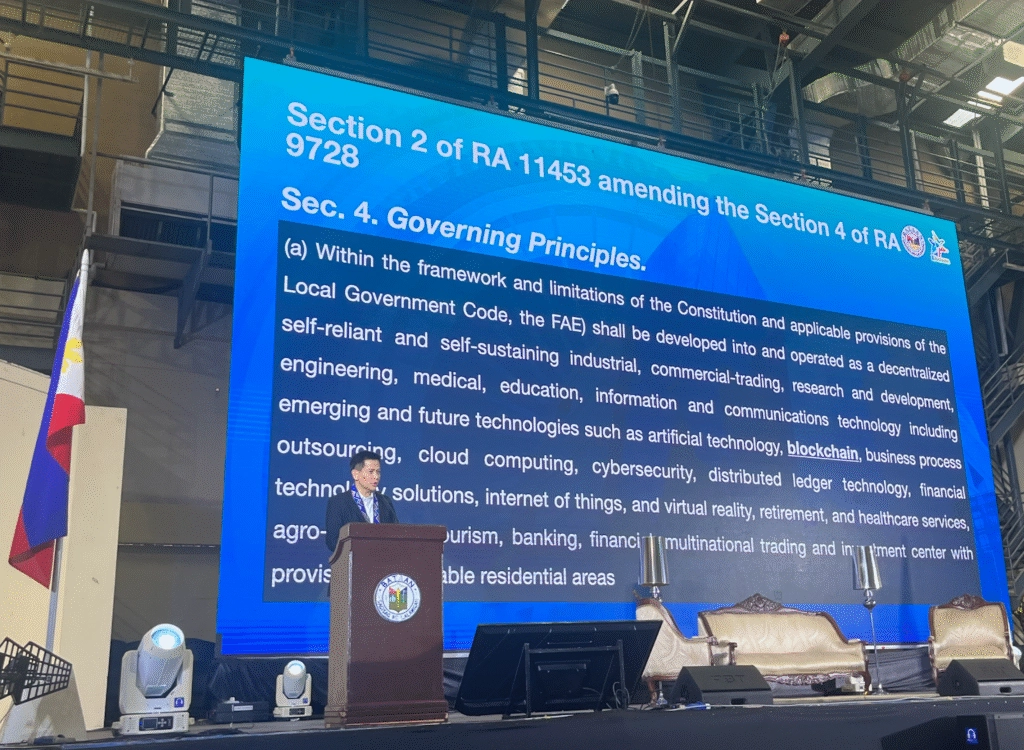|
Getting your Trinity Audio player ready...
|
Bataan Governor Jose Enrique Garcia III outlined an ambitious plan to transform the Bataan Nuclear Power Plant (BNPP) into a hyperscale data center and IT hub, positioning the province as a major player in the digital economy. Bataan is a province in central Luzon, Philippines.
- Transforming the Bataan Nuclear Power Plant into a data center
- Bataan’s infrastructure and projects
- Blockchain in governance
- Bataan aims for data-driven governance
- First blockchain-based meritocracy system
“Together with the DICT, we’re working to convert the Bataan Nuclear Power Plant into a hyperscale data center and IT hub integrating renewable energy, cloud infrastructure, and even resort development,” Garcia said during his speech at the Global Emerging Tech Summit 2025 held in Balanga City, Bataan. “The Philippines will have one of the most secure and iconic data centers in the world.”
The governor added that critics may call the plan bold, but he sees it as achievable. “Some say that’s ambitious. I say if Dogecoin can hit $90 billion because of memes, surely Bataan in the Philippines can power Asia’s next digital hub.”
Garcia’s remarks position Bataan at the intersection of sustainability, innovation, and governance. Once a dormant energy site, the BNPP may soon power a new kind of industry: digital infrastructure supporting cloud computing, artificial intelligence (AI), and blockchain applications.
Infrastructure for a connected peninsula
Garcia began his address at examining Bataan’s geography and development strategy. “We are a peninsula composed of one city and 11 municipalities, 237 barangays, and around one million people surrounded by water. On the east is Manila Bay. And on the other side is the West Philippine Sea.”
He likened the province’s progress to blockchain technology. “We may be a small province, but like a blockchain network, every block, every barangay adds value to the chain. That’s how progress happens here. One verified block at a time.”
Among the province’s infrastructure priorities is the Bataan Interlink Bridge, a 32-kilometer project expected to link Central Luzon to Cavite and the National Capital Region (NCR). “Imagine from Bataan to NAIA [Ninoy Aquino International Airport] in under 40 minutes travel,” Garcia said. “That’s faster than the time it takes for Bitcoin to confirm a transaction on a busy day.”
He also discussed another project under study, the Manila Bay Coastal Defense and Expressway Project. The proposed infrastructure would connect Bataan, Pampanga, and Bulacan. “Not only will it be the solution to the decades-long flooding in Central Luzon, but it’ll also be a faster and alternative road to Metro Manila. If this gets built, we’ll only be 30 minutes away from the National Capital Region,” he said.
Emerging tech in law and governance

The governor credited the province’s openness to innovation to Republic Act 11453, which expanded the Freeport Area of Bataan‘s charter authority. “This amended the charter authority of the Freeport Area of Bataan to include blockchain, artificial intelligence, and other emerging technologies among its governing principles,” Garcia said. “So yes, blockchain isn’t just a buzzword in Bataan, it’s in our law.”
He emphasized that the legal foundation enables both local and global innovators to operate in Bataan’s ecosystem. “If anyone says blockchain has no use case, tell them it’s literally written in our Republic Act,” he said.
Bataan’s commitment to technology has contributed to measurable growth. “In 2024, Bataan achieved 9.3% GDP growth, and now holds the highest GDP per capita amongst all provinces,” Garcia said.
Trust, merit, and blockchain in governance
For Garcia, technology is not just about innovation but about accountability. “The true foundation of progress isn’t infrastructure, it’s trust and merit,” he said. “We all believe good governance should work like blockchain — transparent, traceable, and performance-based.”
The province has already adopted a performance-based incentive system for local governments. “We’ve started with the One Bataan Seal of Healthy Barangay, where 237 barangays are monthly evaluated to make sure they are reaching the health outcomes that they need to provide for their constituents,” Garcia said.
He also highlighted the Barangay Master Development Plan, which requires every barangay to submit a ten-year plan. “All projects and programs will be based on their current situation,” he said. “For those who were able to come up with their Barangay Development Master Plan, we provided them with the Barangay Patrol Services.”
According to Garcia, these systems help ensure that every community’s progress is measurable. “This will definitely not only reward their community but also deliver measurable improvements in health and local development,” he said.
Data-driven governance
Garcia explained that governance in Bataan is increasingly informed by real-time data. “Across our special bodies—the Development Council, the School Board, the Health Board, and the Peace and Order Council—we now gather and analyze real-time data,” he said.
He described how the province tracks performance indicators across sectors. “Tourism arrivals allow us to map the tourism potential or capabilities of our local government units,” he said. “Then, for energy consumption—since it is very difficult to survey the income of our people, the energy consumption is a good way to find out the economic capacity of our people.”
He added that energy data correlates strongly with local economic health. “For the past decade, growth in energy consumption in Bataan has always been in double digits. This is proof of growth and productivity in the province,” Garcia said.
Health outcomes are also tracked. “This shows smoking prevalence, hypertension, and diabetes prevalence in our province,” he said. “It also shows the overall health score of each and every local government unit.”By presenting this data during provincial health board meetings, officials can benchmark and compete to improve results. “They try to find a way to be able to improve and move up the rank of the table that we show them constantly,” Garcia said.
Crime and education are other areas where data informs decisions. “These are the incidents, the crimes that happened here in our province,” he said. “Again, we can show them for LGU per barangay so that our local government units and officials are up their toes making sure that their barangays and municipalities are indeed safe.”
On education, he said, “Bataan is one of the first provinces to hold periodical exams for senior students for select schools online. By holding this online, using our learning management system, we’re able to gather the performance of each school and the scores of each and every student.”
Building the first blockchain-based meritocracy system
Garcia said the next step is to ensure that all this data is secure, verified, and auditable. “Data alone isn’t enough. It must be verified, auditable, and tamper-proof. And that’s where blockchain technology secures the integrity of governance,” he said.
He called on developers, investors, and innovators to collaborate. “We need your help to build the first blockchain-based meritocracy system in governance,” Garcia said. “A system where every LGU’s performance is accurately measured and transparent, where incentives are released automatically, maybe through smart contracts, and where decisions are grounded on verified data.”
In his words, “We don’t just HODL Bitcoin or crypto; we try to HODL good governance. In crypto, they say ‘Don’t trust, verify.’ In governance, we say build trust, then amplify.”
He concluded by connecting technology with trust. “If we can record good governance and performance the way we record blockchain transactions—permanent, transparent, and accountable—then we won’t just gain better data. We’ll earn the much-needed deeper trust of our people,” Garcia said.
Watch | Combatting threats in digital banking: WFIS 2025 Philippines Highlights

 12-10-2025
12-10-2025 





